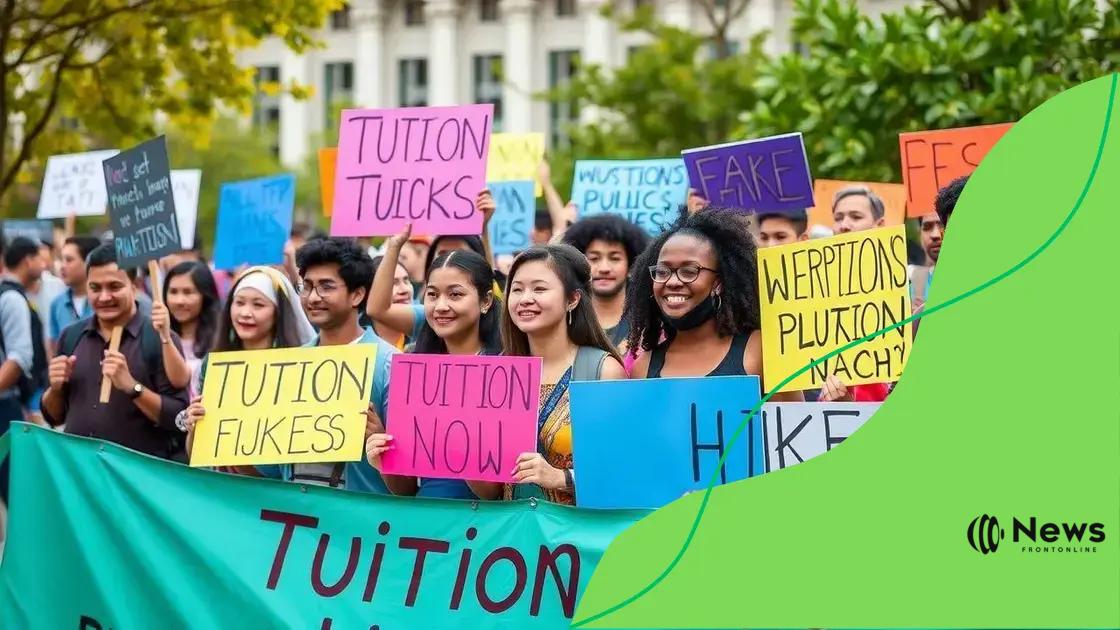Public outcry over tuition hikes sparks change
Public outcry over tuition hikes is driving movements for change, with students advocating for more affordable education through protests, online campaigns, and innovative funding solutions.
Public outcry over tuition hikes has become a significant issue as students and families voice their frustrations. Have you noticed how rising costs are reshaping the educational landscape? In this article, we’ll delve into the motivations behind these hikes and explore the movements arising in response.
Understanding the reasons behind tuition increases
Understanding the reasons behind tuition increases is crucial for students and families. Many factors contribute to the surge in college costs, often leaving individuals confused and frustrated. By exploring these factors, we can gain insight into this pressing issue.
The Role of State Funding
One significant reason tuition has increased is the decline in state funding for public universities. Over the years, states have reduced their financial support, forcing institutions to raise tuition to cover operating costs.
Rising Operational Costs
Colleges also face rising operational costs that contribute to tuition hikes. Expenses like salaries, facility maintenance, and technology upgrades are increasing. As these costs rise, schools pass on a portion to students. In light of these issues, it’s essential to understand how these expenditures impact tuition.
- Administrative costs: An increase in administrative staff can lead to higher expenses.
- Facility upgrades: Maintaining and upgrading campuses creates additional financial burdens.
- Healthcare costs: Rising healthcare expenses for faculty and staff also influence tuition.
Furthermore, increased demand for higher education has created an environment where institutions feel pressured to enhance their services and amenities. Students today expect more than just education; they seek programs and facilities that cater to their needs. To meet these expectations, colleges invest in various resources, which can contribute to tuition increases.
In addition to these factors, external pressures such as economic fluctuations and student debt levels play a role in tuition pricing. As the economy changes, colleges often find themselves adjusting their costs to keep up with the financial landscape. Understanding these elements can give insight into why tuition continues to rise.
Impact of tuition hikes on students and families
The impact of tuition hikes on students and families is profound and far-reaching. As costs rise, many struggle to make ends meet, leading to stressful decisions about education and finances. Understanding these effects can shed light on the broader implications of tuition increases.
Financial Burden on Families
When tuition increases, families often face a significant financial burden. Many parents worry about how to finance their children’s education without going into debt. This worry can lead to difficult conversations about budgeting and savings.
Increased Student Debt
Rising tuition also contributes to increased student debt. Many students rely on loans to cover costs, and as tuition climbs, their debt levels soar higher. This debt can affect their future choices, such as buying a home or starting a family.
- Long-term financial impact: High student debt can delay major life milestones.
- Career choices: Many may choose higher-paying jobs instead of fields they love to manage debts.
- Stress: The pressure of repayment can lead to anxiety and stress among graduates.
Additionally, the emotional toll on students cannot be ignored. Many students feel overwhelmed as they juggle academic pressures with financial concerns. They may have to work part-time jobs, which can affect their academic performance.
As tuition increases, the choices that students make also change. Some may choose to attend less expensive schools, even if it means sacrificing quality. Others might delay their education altogether, opting to work until they can afford the costs. The ripple effects of these decisions extend to the economy as well.
Recent movements against tuition hikes

Recent movements against tuition hikes have gained momentum as students and communities unite to fight rising costs. These movements highlight the dissatisfaction and urgency felt by many who believe education should be more accessible. Activism has taken many forms, making headlines across the country.
Student-Led Protests
One of the most visible forms of resistance has been through student-led protests. Students organize rallies and demonstrations to voice their discontent. These events often draw large crowds, showcasing the collective frustration surrounding tuition increases.
Online Campaigns and Petitions
In addition to physical protests, many are turning to online platforms to amplify their message. Social media campaigns and petitions have become essential tools. They allow individuals to gather support quickly and efficiently. Many organizations emphasize the power of mobilizing people through digital means.
- Hashtag movements: Creating viral hashtags helps spread awareness.
- Petitions: Online petitions can collect thousands of signatures in days.
- Awareness campaigns: Videos and infographics share stories and statistics.
These digital efforts are complemented by traditional advocacy, where groups collaborate with legislators. They aim to push for policies that can alleviate financial burdens. Many activists demand more transparency around how tuition fees are used, advocating for accountability from educational institutions.
The fight against tuition hikes is not just about the costs; it’s about the principle of affordable education. Many believe that education is a right, not a privilege. By engaging in various forms of activism, these movements seek a better future for all students.
Case studies of successful protests
Case studies of successful protests against tuition hikes provide valuable insights into what can be achieved when students and communities unite. These examples not only highlight effective strategies but also show the power of collective action in driving change in higher education.
The University of California System
One notable case is the protests in the University of California (UC) system. In 2015, students organized rallies against tuition increases, demanding action from university officials. Their efforts included sit-ins and a coordinated social media campaign to raise awareness. These protests led to the UC system freezing tuition for several years, making higher education more affordable.
Students at New York University
Another impactful example comes from New York University (NYU). In 2019, students mobilized against rising tuition and housing costs. They created a coalition that involved ongoing discussions with university administration. Key tactics included hunger strikes and public forums, which brought attention to the issues. As a result, NYU agreed to review their financial aid policies and create a tuition task force.
- Power of unity: Collaborating as a cohesive group magnifies their impact.
- Strategic planning: Successful protests often involve well-thought-out strategies.
- Engagement with media: Effective use of media can amplify their message.
These case studies reflect the determination and resourcefulness of students fighting for educational access. By sharing their stories, other universities can learn from these experiences. They illustrate how grassroots movements can challenge institutions and foster change in the landscape of higher education.
Future of tuition in higher education
The future of tuition in higher education is a topic that stirs much debate. As costs continue to rise, questions about sustainability, accessibility, and innovation are more pressing than ever. Many experts and students are calling for change to make education more affordable.
Shifts in Funding Models
One potential shift is the change in funding models for universities. Some institutions are exploring alternatives to traditional tuition systems. For example, income-share agreements allow students to pay a percentage of their future income instead of upfront tuition fees. This approach could alleviate financial stress.
Increased Investment in Online Education
Another trend is the increased investment in online education. Online programs often have lower overhead costs, which can help reduce tuition fees. As more students seek flexible learning options, universities may expand their online offerings, making education more accessible to everyone.
- Hybrid learning models: Combining in-person and online classes can enhance learning.
- Corporate partnerships: Collaborations with businesses can lead to sponsorships and funding.
- Use of technology: Innovations in educational technology may improve efficiency and reduce costs.
Additionally, there is a growing focus on creating pathways for students from diverse backgrounds. Initiatives aimed at increasing representation and support for underprivileged students can help create a more equitable system. By focusing on inclusion, the higher education landscape can become more diverse while addressing tuition costs.
As discussions surrounding these changes continue, students and educators alike are advocating for a more sustainable approach to tuition. The future may involve a combination of innovative funding options and increased use of technology. Ultimately, creating a system that promotes access to education for all remains the goal.
FAQ – Frequently Asked Questions about Tuition Hikes and Higher Education
What are the main reasons for tuition hikes?
Tuition hikes are often due to increased operational costs, reduced state funding, and higher demand for educational services.
How do tuition hikes affect students and families?
They can lead to financial strain, increased student debt, and may force families to make tough decisions about education.
What actions are students taking against tuition increases?
Students are organizing protests, creating online campaigns, and advocating for policy changes to address tuition hikes.
What is the future outlook for tuition in higher education?
The future may involve innovative funding models, increased online education, and a focus on making education more accessible.





